Ghost Shark
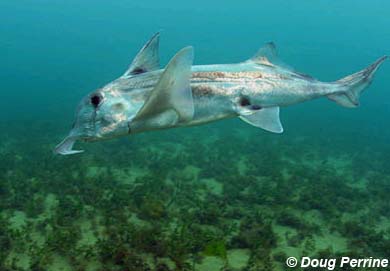
Callorhinchus milii
This unusual family of ‘chimaera’ branched off from sharks almost 400 million years ago. The ghost shark is easily identified because of their very large, high-set eyes, and the club-like structure at the end of their snouts. Their protruding snout is made to search for food prey in the sand, and is highly sensitive to electric fields and movement. They have a dangerous spine just ahead of their dorsal fin, and sport fishers should handle this shark with caution.
Order – Chimaeriformes
Family – Callorhinchidae
Genus – Callorhinchus
Species – milii
Common Names
English language common names include ghost shark, elephant fish, elephant shark, silver trumpeter, and whitefish. Other common names are Australská sloní ryba (Czech), elefanten-chimäre (German), makorepe (Maori), masca laboureur (French), and reperepe (Maori).
Importance to Humans
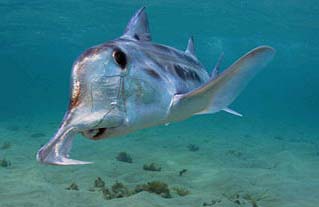
The ghost shark is caught commercially along the continental shelf off southern Australia and New Zealand. It is often sold as silver trumpeter or whitefish fillets and used in “fish and chips”. This species is non-targeted and often caught in the red cod and flatfish fisheries. However, there is still a directed fishery for the ghost shark on the Canterbury coast by inshore vessels. In the waters surrounding New Zealand the catch may approach 1,000 tonnes, the majority of which is exported to Australia.
It is also highly treasured for consumption by the Ngai Tahu Maori tribe. In pre-European times, ghost sharks were netted during the summer months, then dried and stored in kelp bags. It continues to be targeted by the Ngai Tahu, with over 80% of the total New Zealand catch taken in the waters of the Ngai Tahu region.
Danger to Humans
Ghost sharks have a long spine located just in front of the first dorsal fin and is used to defend themselves against potential predators. Humans should take care when handling this fish to avoid injury.
Conservation
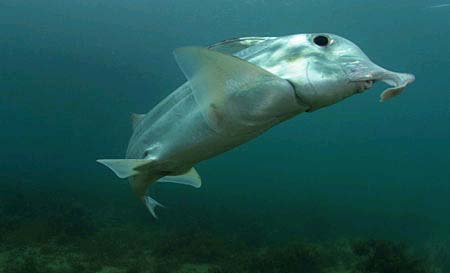
The ghost shark is currently listed as “Least Concern” with the World Conservation Union (IUCN).
> Check the status of the ghost shark at the IUCN website.
The IUCN is a global union of states, governmental agencies, and non-governmental organizations in a partnership that assesses the conservation status of species. A listing as “Least Concern” indicates that this species does not qualify for “Endangered”, “Vulnerable”, or “Near Threatened”. This category includes widespread and abundant species; the ghost shark is considered relatively abundant throughout its geographic range.
In the waters off southern Australia, commercial catch of the ghost shark has remained stable over the past 20 years. However, a three mile closure of all Victorian waters to shark fishing provides a refuge for many species including the ghost shark. In both Australia and New Zealand, “Total Allowable Catch” quotas are in place and have increased over time. The ghost shark fishery appears to be stable due to its high productivity.
Geographical Distribution
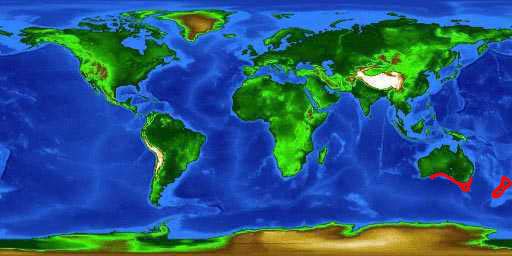
The ghost shark resides in the southwestern Pacific Ocean along the temperate coasts of southern Australia and New Zealand.
Habitat
This chimaera resides on continental shelves of cool temperate areas to depths to at least 656 feet (200 m). It has also been reported to migrate into estuaries and inshore bays during the spring months to mate.
Biology
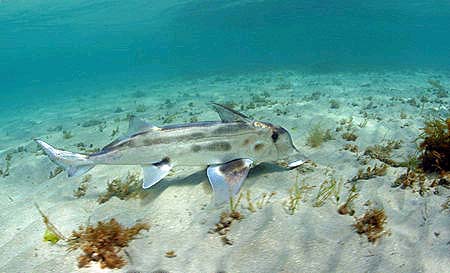
Distinctive Features
The ghost shark is easy to recognize due to the small club-like structure located on the snout. The mouth is located just behind the snout and the eyes which are often green are large and set high on the head. There is a single gill opening immediately in front of the pectoral fin origin on each side of the fish. The pectoral fins are large, providing a primary means of locomotion. There are two widely spaced dorsal fins. There is a spine located just anterior to the first dorsal fin; the first dorsal fin is much taller than the second dorsal fin and the anal fin is taller than the caudal fin. The caudal fin is broadest at the lower lobe origin and lacks a caudal filament. The upper lobe of the caudal fin is much longer than the lower lobe.
The males possess retractable copulation organs, referred to as claspers, located near the pelvic fins. These prepelvic claspers are spoon-shaped and consist of frill-like lobes and a globular gland. There is also a thumb-shaped clasper located on the head used to secure the female during copulation.
Coloration
The body is silvery white, similar to aluminum foil in color and occasionally has dark markings posterior to the eyes as well as on the fins.
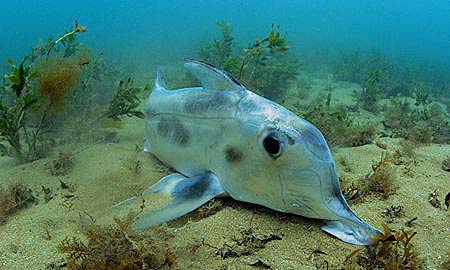
Dentition
The ghost shark has three pairs of hypermineralized tooth plates. The anterior tooth plates of the upper jaw are sharp and blade-like while the anterior tooth plates of the lower jaw are flat used for crushing hard prey items. The teeth of the ghost shark continue to grow and are not shed and replaced as they are in sharks. The gums of the upper jaw have enlarged papillae.
Denticles
The body of the ghost shark is smooth and lacks thorns and denticles.
Size, Age, and Growth
The maximum reported size of the ghost shark is 49 inches (125 cm) total length. Males reach maturity at 2-3 years of age, corresponding to 19.7 inches (50 cm) total length, while females mature at 4-6 years of age and 27.6 inches (70 cm) total length. The lifespan of the ghost shark is approximately 15 years.
Food Habits
The club-like projection on the snout of the ghost shark is used to search for prey. The end is covered in pores that sense movement and weak electrical fields. Ghost sharks feed primarily on shellfish and molluscs including the clam Maorimactra ordinaria.
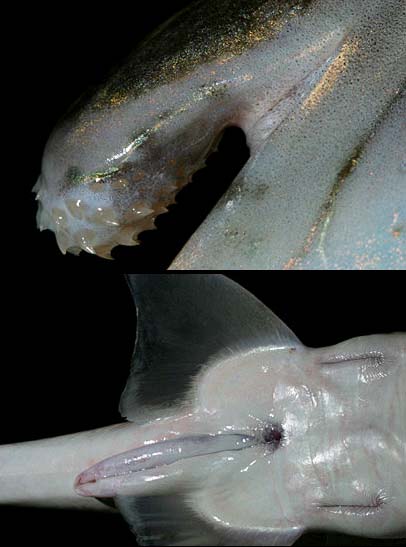
Reproduction
The ghost shark is oviparous. Two keratinous egg cases are released during the spring months onto sandy or muddy bottoms in shallow water. The egg cases measure up to 25 cm in length and 10 cm in width and are golden yellow in color. During the following 8 months, the embryos remain in the egg cases feeding solely on yolk. The coloration of the egg case changes through time, from golden yellow when first released by the female to brown and black prior to hatching. When the young hatch, they measure about 15 cm in length. They will move from the shallow water nursery area to deeper water as they grow.
Predators
Predators of the ghost shark include larger fish including sharks.
Parasites
Parasites of the ghost shark include the monogenean Callorhynchicola multitesticulatus as reported from a specimen caught in the waters off the eastern coast of New Zealand. Another documented parasite of the ghost shark is the cestode Gyrocotyle rugosa.
Taxonomy
Callorhinchus milii was originally described by Bory de Saint-Vincent in 1823. It is considered a “chimaera”, a relative of the sharks, rays, and skates. There have been numerous misspellings of this name including Callorhynchus milii, Callorhynchus milli, and Callorhynchus millii. The genus name, Callorhinchus, is derived from the Greek “kalos, kallos” meaning beautiful and the Greek ” rhyngchos” meaning snout, in reference to the appearance of this fish. Synonyms appearing in past scientific literature include Callorhynchus tasmanius Richardson 1840, Callorhynchus australis Owen 1854, and Callorhynchus dasycaudatus Colenso 1879.
Prepared by: Cathleen Bester